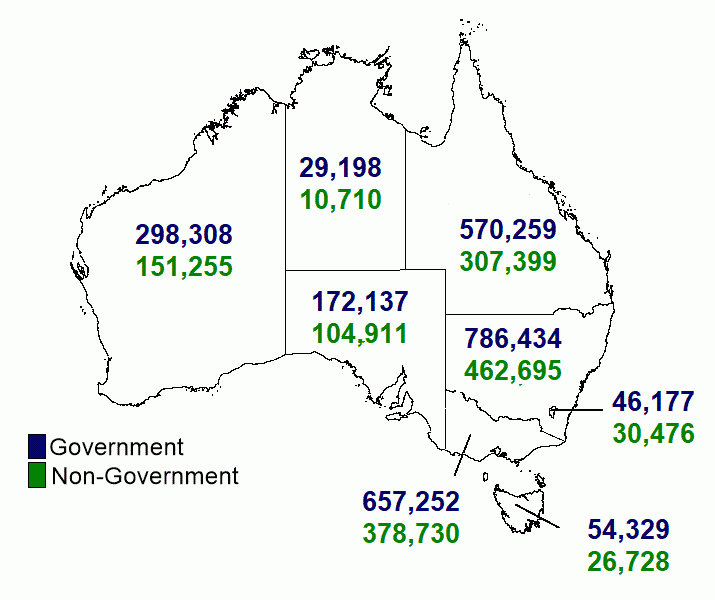In 2023:
- 4,086,998 students were enrolled in schools across Australia, an increase of 44,486 students (1.1%) compared with 2022.
- the majority of students were enrolled in government schools (64.0%), followed by Catholic schools (19.7%) and independent schools (16.3%).
Over the five years to 2023, total student enrolments increased by 3.5%. Independent schools recorded the largest increase (14.1%), followed by Catholic schools (4.8%) and government schools (0.7%).
| 2023 | 2022 | 2021 | 2020 | 2019 | 2019-23 (% change) | |
|---|---|---|---|---|---|---|
| Government | 2,614,094 | 2,605,826 | 2,622,755 | 2,629,143 | 2,594,830 | 0.7 |
| Catholic | 806,323 | 795,368 | 787,181 | 778,605 | 769,719 | 4.8 |
| Independent | 666,581 | 641,318 | 620,781 | 599,226 | 584,262 | 14.1 |
| Total | 4,086,998 | 4,042,512 | 4,030,717 | 4,006,974 | 3,948,811 | 3.5 |
The highest annual growth rates of student enrolments in 2023 were in:
- Western Australia: 2.1%
- Victoria: 2.0%
- Australian Capital Territory: 0.9%
- Queensland: 0.8%
Tasmania had a fall in growth rate of -0.6%.
Population growth rates for 5 to 19 year olds in 2023 were:
- Western Australia: 2.8%
- Victoria: 2.5%
- Queensland: 1.9%.
The lowest was in the Northern Territory (0.1%).
Further information on population growth rates can be accessed from National, state and territory population, June 2023.
In 2023, the annual growth rate for school enrolments was 1.1% (44,486 more students) since 2022:
- government school enrolments recorded an increase of 0.3% (8,268 more students).
- non-government school enrolments recorded an increase of 2.5% (36,218 more students).
Primary school enrolments increased by 12,593 students compared with the year before (a change of 0.6%):
- government primary school enrolments remained relatively unchanged 0.0% (48 more students).
- non-government primary school enrolments increased 1.8% (12,545 more students).
Secondary school enrolments increased by 31,893 students (a change of 1.8%):
- government secondary school enrolments increased 0.8 % (8,220 more students).
- non-government secondary school enrolments grew by 3.2 % (23,673 more students).
In 2023 the number of Full-Fee Paying Overseas Students (FFPOS) contributed to the higher growth rate, increasing by over a third (36.6%) from 2022 to 21,124 students. Between 2019-2022 there was a drop of 41.9%, primarily due to the COVID-19 pandemic.
- FFPOS numbers are collected in the National Schools Statistics Collection (NSSC) but not published in the Schools data cubes.
- The above calculations exclude the FFPOS numbers for Northern Territory government schools, as 2019 and 2020 data unavailable in the NSSC. Graph 5 does include Northern Territory government schools FFPOS data for 2021-2023.
In the year ending 30 June 2023, overseas migration contributed a net gain of 518,000 people to Australia's population. This was the largest net overseas migration estimate since records began. (see Overseas Migration).
Data unavailable for Northern Territory government schools in 2019 and 2020.
The proportion of students enrolled in non-government schools in 2023 was:
- highest in the Australian Capital Territory (39.8%) and South Australia (37.9%).
- lowest in the Northern Territory (26.8%).
- lower for students enrolled in schools in very remote areas (11.6%) than for remote areas (22.9%), outer regional areas (29.5%), inner regional areas (36.1%) and major cities (37.2%).
Map 1. Student enrolment counts by state and territory and school affiliation, 2023
Image

Description
A map of Australia showing student enrolment counts by state and territory and affiliation for 2023. Western Australia 298,308 Government student enrolments; 151,255 Non-Government enrolments. Northern Territory 29,198 Government student enrolments; 10,710 Non-Government enrolments. South Australia 172,137 Government student enrolments; 104,911 Non-Government enrolments. Victoria 657,252 Government student enrolments; 378,730 Non-Government enrolments. Tasmania 54,329 Government student enrolments; 26,728 Non-Government enrolments. New South Wales 786,434 Government student enrolments; 462,695 Non-Government enrolments. Australian Capital Territory 46,177 Government student enrolments; 30,476 on-Government student enrolments. Queensland 570,259 Government student enrolments; 307,399 Non-Government enrolments.